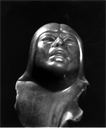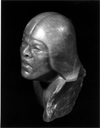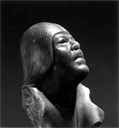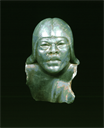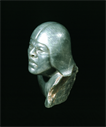Description
Although it has suffered considerable damage, this jewel of Olmec lapidary art is among the most outstanding examples of portable Olmec sculpture. In fact, the bold percussion that separated the bust from the body lends a striking and dramatic air to the piece. It is noteworthy that the exquisite face received no damage from what appears to have been intentional and controlled mutilation. The curving indentations in the area of both shoulders suggest "bulbs of percussion" from where the bust was fractured from the body. However, according to lithic experts these indentations are secondary and occurred after the bust was removed from the body. The statuette appears to have been first broken across the trunk. From this initial platform, two blows were struck up the body to remove the sides of the torso as well as shoulders and arms. A final, major blow was made again across the torso, thereby creating a relatively flat base for the bust.
The jade is a soft, blue color and highly translucent, with flecks of white inclusions. The surface is crazed with fine fracture lines, possibly from the sharp blows by which the bust was reduced from a statuette. The only clear evidence of drilling appears in the rather large nostrils, which are joined through the septum. The nostrils contain reddish soil that also adheres to the face and to areas of rougher and deeper breakage. The delicately carved face is covered by fine striations executed by a sharp tool, suggesting that it was not simply ground, but carved by the fine point of a quartz crystal or other tool used for hard-stone incision. Considerable care was exerted in the area of the eyes and brow, which is creased by four diagonal lines. The eyes are composed of V-shaped channels, making it unlikely that they once held inlay. The partly opened mouth exposes the upper teeth, with the incisors indicated by fine line incision.
Among the more striking traits of this figure is the mane of shoulder length hair, separated by a deep part running down the center of the head. The filaments of hair are delineated by a controlled series of incised lines. From the same point along the part, pairs of lines run in opposite directions down the sides of the head. These carefully spaced lines continue to the back, but due to the shape of the cranium, some converge as they descend.
According to Elizabeth Benson, the jadeite bust probably represents a historical personage. The basic identity of this being has been a source of some debate while some authors identify the bust as the one of a woman; others think that both the facial features and hairstyle suggest that the Dumbarton Oaks bust represents a male Olmec ruler.
Bibliography
Alcina Franch, José 1979 Die Kunst Des Alten Amerika. Grosse Epochen Der Weltkunst. Ars Antiqua. Herder, Freiburg. fig. 232.
Benson, Elizabeth P. 1963 Handbook of the Robert Woods Bliss Collection of Pre-Columbian Art. Dumbarton Oaks, Trustees for Harvard University, Washington, D.C., p. 7, cat. 30.
Benson, Elizabeth P. (ED.) 1981 The Olmec and Their Neighbors: Essays in Memory of Matthew W. Stirling. Dumbarton Oaks Research Library and Collections, Trustees for Harvard University, Washington, D.C., p. 100.
Benson, Elizabeth P. 1981 Some Olmec Objects in the Robert Woods Bliss Collection at Dumbarton Oaks. In The Olmec and Their Neighbors: Essays in Memory of Matthew W. Stirling, Elizabeth P. Benson, ed., pp. 95-108. Dumbarton Oaks Research Library and Collections, Trustees for Harvard University, Washington, D.C.
Benson, Elizabeth P. and Beatriz de la Fuente (EDS.) 1996 Olmec Art of Ancient Mexico. National Gallery of Art, Washington.
Berrin, Kathleen and Virginia M. Fields (EDS.) 2010 Olmec: Colossal Masterworks of Ancient Mexico. Fine Arts Museums of San Francisco, Los Angeles County Museum of Art, San Francisco, Los Angeles. p. 81, 188, pl. 97-98, fig. 45.
Bliss, Robert Woods 1957 Pre-Columbian Art: The Robert Woods Bliss Collection. Text and Critical Analyses by S. K. Lothrop, Joy Mahler and William F. Foshag. Phaidon, New York. p. 234, cat. 9, pl. III.
Burchwood, Katharine Tyler 1972 The Origin and Legacy of Mexican Art. A. S. Barnes, South Brunswick. pl. 3.
Coe, Michael D. 1965 The Olmec Style and Its Distributions. In Handbook of Middle American Indians; Vols. 2-3: Archaeology of Southern Mesoamerica, Gordon Randolph Willey, ed. University of Texas Press, Austin. p. 746, fig. 15.
Covarrubias, Miguel 1946 Mexico South, the Isthmus of Tehuantepec. 1st ed. A. A. Knopf, New York. pl. 11.
Covarrubias, Miguel 1957 Indian Art of Mexico and Central America. 1st ed. Knopf, New York. cat. 9, pl. IX.
Covarrubias, Miguel 1944 La Venta, Colossal Heads and Jaguar Gods. Dyn (6).
Davies, Nigel 1983 The Ancient Kingdoms of Mexico. Pelican Books. Penguin Books, New York. fig. 2.
de la Fuente, Beatriz 1977 Pequeña Obra Maestra De La Escultura Olmeca. Anales del Instituto de Investigaciones Estéticas 47. p. 7-8, fig. 8.
Diehl, Richard A. 2010 The Olmec Legacy in Stone: A Mesoamerican Alpha and Omega. In Olmec: Colossal Masterworks of Ancient Mexico, Kathleen Berrin and Virginia M. Fields, eds., pp. 76-85. Fine Arts Museums of San Francisco, Los Angeles County Museum of Art, San Francisco, Los Angeles. p. 81, fig. 45.
González Calderón, O. L. 1991 The Jade Lords. O.L. González Calderón, Coatzacoalcos, Ver., pl. 410.
Gump, Richard 1962 Jade: Stone of Heaven. Doubleday & Company, Garden City, NJ. p. 192-3
Informant, Guest, (unpublished). p. 99.
Kubler, George 1962 The Art and Architecture of Ancient America; the Mexican, Maya, and Andean Peoples. The Pelican History of Art, Z21. Penguin Books, Baltimore. p. 70, pl. 34(b).
Kubler, George 1984 Ancient American Gods and Their Living Impersonators. Apollo CXIX (266):10-20. fig. 1 & 2.
Mark, Joan T. 2000 The Silver Gringo: William Spratling and Taxco. 1st ed. University of New Mexico Press, Albuquerque.
Mason, J. Alden 1958 Pre-Columbian Art (Review Article on 1957 Catalogue). Archaeology 11 (2):123-4.
Pasztory, Esther 2002 Truth in Forgery. Res 42:159-165. p. 161.
Stirling, Matthew Williams 1961 The Olmecs, Artists in Jade. In Essays in Pre-Columbian Art and Archaeology, Samuel K. Lothrop et al., ed., Cambridge. p. 51, 53, 48, fig. 5 & 6.
Stirling, Matthew Williams, Michael D. Coe, David C. Grove and Elizabeth P. Benson 1981 The Olmec & Their Neighbors: Essays in Memory of Matthew W. Stirling. Dumbarton Oaks Research Library and Collections Trustees for Harvard University, Washington, D.C., p. 100.
Taube, Karl A. 2004 Olmec Art at Dumbarton Oaks. Pre-Columbian Art at Dumbarton Oaks; No. 2. Dumbarton Oaks Research Library and Collection, Washington, D.C., p. 100-101, pl. 16.
Exhibition History
"Indigenous Art of the Americas", National Gallery of Art, Washington DC, August 1949 to July 1962.
"Olmec Art of Ancient Mexico", National Gallery of Art, Washington DC, 6/30 - 10/20/1996.
"Olmec: Colossal Masterworks of Ancient Mexico", Los Angeles County Museum of Art, Los Angeles, CA, 10/02/2010 to 01/09/2011; de Young, Fine Arts Museum of San Francisco, San Francisco, CA, 02/19 - 05/08/2011.

